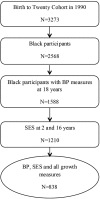Association of socioeconomic status change between infancy and adolescence, and blood pressure, in South African young adults: Birth to Twenty Cohort
- PMID: 27029771
- PMCID: PMC4823398
- DOI: 10.1136/bmjopen-2015-008805
Association of socioeconomic status change between infancy and adolescence, and blood pressure, in South African young adults: Birth to Twenty Cohort
Abstract
Objective: Social epidemiology models suggest that socioeconomic status (SES) mobility across the life course affects blood pressure. The aim of this study was to investigate the association between SES change between infancy and adolescence, and blood pressure, in young adults, and the impact of early growth on this relationship.
Setting: Data for this study were obtained from a 'Birth to Twenty' cohort in Soweto, Johannesburg, in South Africa.
Participants: The study included 838 Black participants aged 18 years who had household SES measures in infancy and at adolescence, anthropometry at 0, 2, 4 and 18 years of age and blood pressure at the age of 18 years.
Methods: We computed SES change using asset-based household SES in infancy and during adolescence as an exposure variable, and blood pressure and hypertension status as outcomes. Multivariate linear and logistic regressions were used to investigate the associations between SES change from infancy to adolescence, and age, height and sex-specific blood pressure and hypertension prevalence after adjusting for confounders.
Results: Compared to a persistent low SES, an upward SES change from low to high SES tertile between infancy and adolescence was significantly associated with lower systolic blood pressure (SBP) at the age of 18 years (β=-4.85; 95% CI -8.22 to -1.48; p<0.01; r(2)=0.1804) after adjusting for SES in infancy, small-for-gestational-age (SGA) and weight gain. Associations between SES change and SBP were partly explained by weight gain between birth and the age of 18 years. There was no association between SES mobility and diastolic blood pressure, mean arterial pressure or hypertension status.
Conclusions: Our study confirms that upward SES change has a protective effect on SBP by the time participants reach young adulthood. Socioeconomic policies and interventions that address inequality may have the potential to reduce cardiovascular disease burden related to BP in later life.
Keywords: EPIDEMIOLOGY; SOCIAL MEDICINE.
Published by the BMJ Publishing Group Limited. For permission to use (where not already granted under a licence) please go to http://www.bmj.com/company/products-services/rights-and-licensing/
Figures
Similar articles
-
Associations between household and neighbourhood socioeconomic status and systolic blood pressure among urban South African adolescents.J Biosoc Sci. 2012 Jul;44(4):433-58. doi: 10.1017/S0021932012000107. Epub 2012 Apr 11. J Biosoc Sci. 2012. PMID: 22490826
-
Approaches for assessing the role of household socioeconomic status on child anthropometric measures in urban South Africa.Am J Hum Biol. 2009 Jan-Feb;21(1):48-54. doi: 10.1002/ajhb.20814. Am J Hum Biol. 2009. PMID: 18770528
-
Blood pressure tracking in urban black South African children: birth to twenty cohort.BMC Pediatr. 2015 Jul 15;15:78. doi: 10.1186/s12887-015-0402-z. BMC Pediatr. 2015. PMID: 26173634 Free PMC article.
-
Socio-economic status and blood pressure: an overview analysis.J Hum Hypertens. 1998 Feb;12(2):91-110. doi: 10.1038/sj.jhh.1000558. J Hum Hypertens. 1998. PMID: 9504351
-
Hypertension: detection and management in South Africa.Nephron Clin Pract. 2010;116(4):c269-73. doi: 10.1159/000318788. Epub 2010 Jul 16. Nephron Clin Pract. 2010. PMID: 20639673 Review.
Cited by
-
Practice Change Needed for the Identification of Pediatric Hypertension in Marginalized Populations: An Example From South Africa.Front Pediatr. 2022 May 11;10:877431. doi: 10.3389/fped.2022.877431. eCollection 2022. Front Pediatr. 2022. PMID: 35633959 Free PMC article.
-
Self-reported hypertension prevalence, risk factors, and knowledge among South Africans aged 24 to 40 years old.J Hum Hypertens. 2025 Feb;39(2):177-187. doi: 10.1038/s41371-024-00957-8. Epub 2025 Feb 24. J Hum Hypertens. 2025. PMID: 39994423 Free PMC article.
-
Social mobility across the lifecourse and DNA methylation age acceleration in adults in the UK.Sci Rep. 2022 Dec 24;12(1):22284. doi: 10.1038/s41598-022-26433-2. Sci Rep. 2022. PMID: 36566336 Free PMC article.
-
The impact of HIV and ART exposure during pregnancy on fetal growth: a prospective study in a South African cohort.BMC Pregnancy Childbirth. 2023 Jun 3;23(1):415. doi: 10.1186/s12884-023-05743-x. BMC Pregnancy Childbirth. 2023. PMID: 37270499 Free PMC article.
-
Influence of blood pressure level and age on within-visit blood pressure variability in children and adolescents.Eur J Pediatr. 2018 Feb;177(2):205-210. doi: 10.1007/s00431-017-3049-y. Epub 2017 Dec 4. Eur J Pediatr. 2018. PMID: 29204850
References
Publication types
MeSH terms
Grants and funding
LinkOut - more resources
Full Text Sources
Other Literature Sources
Medical

